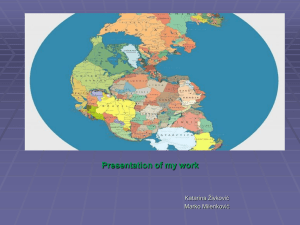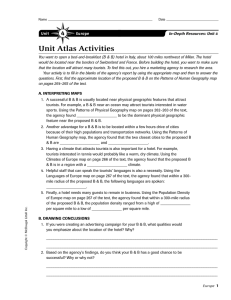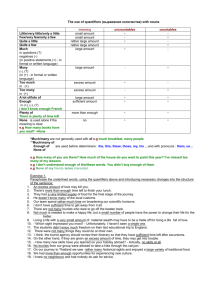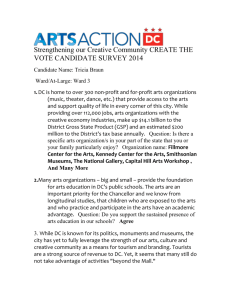This file was created by scanning the printed publication.
advertisement
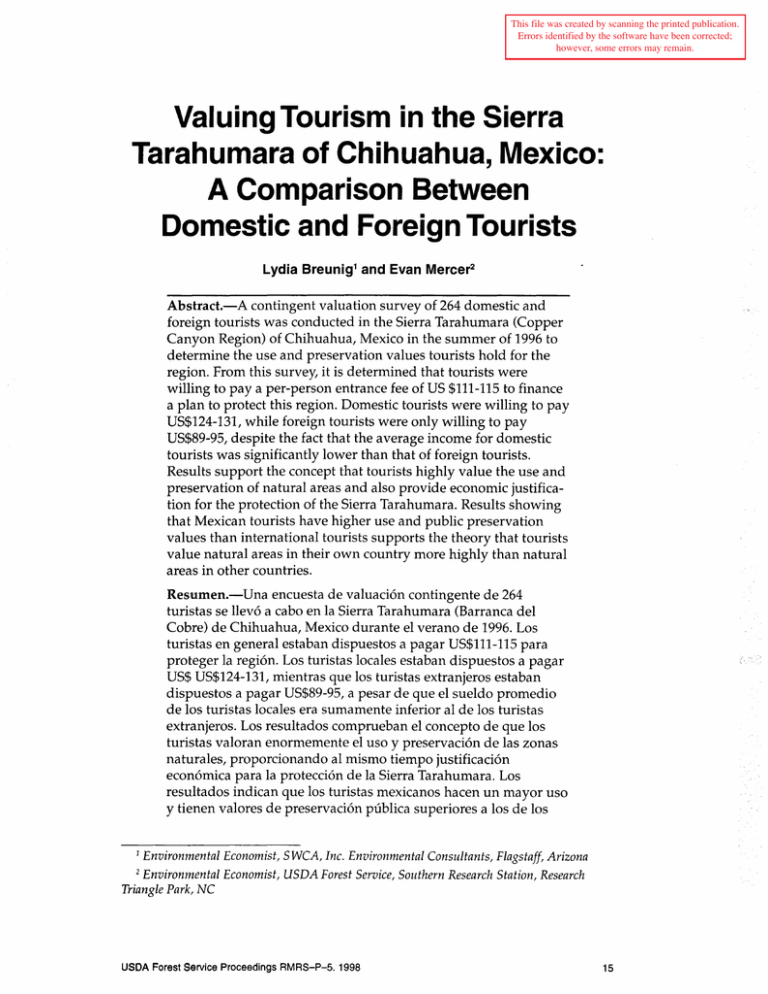
This file was created by scanning the printed publication.
Errors identified by the software have been corrected;
however, some errors may remain.
Valuing Tourism in the Sierra
Tarahumara of Chihuahua, Mexico:
A Comparison Between
Domestic and Foreign Tourists
Lydia Breunig 1 and Evan Mercer2
Abstract.-A contingent valuation survey of 264 domestic and
foreign tourists was conducted in the Sierra Tarahumara (Copper
Canyon Region) of Chihuahua, Mexico in the summer of 1996 to
determine the use and preservation values tourists hold for the
region. From this survey, it is determined that tourists were
willing to pay a per-person entrance fee of US $111-115 to finance
a plan to protect this region. Domestic tourists were willing to pay
US$124-131, while foreign tourists were only willing to pay
US$89-95, despite the fact that the average income for domestic
tourists was significantly lower than that of foreign tourists.
Results support the concept that tourists highly value the use and
preservation of natural areas and also provide economic justification for the protection of the Sierra Tarahumara. Results showing
that Mexican tourists have higher use and public preservation
values than international tourists supports the theory that tourists
value natural areas in their own country more highly than natural
areas in other countries.
Resumen.-Una encuesta de valuaci6n contingente de 264
turistas se llev6 a cabo en la Sierra Tarahumara (Barranca del
Cobre) de Chihuahua, Mexico durante el verano de 1996. Los
turistas en general estaban dispuestos a pagar US$111-115 para
proteger la region. Los turistas locales estaban dispuestos a pagar
US$ US$124-131, mientras que los turistas extranjeros estaban
dispuestos a pagar US$89-95, a pesar de que el sueldo promedio
de los turistas locales era sumamente inferior al de los turistas
extranjeros. Los resultados comprueban el concepto de que los
turistas valoran enormemente el uso y preservaci6n de las zonas
naturales, proporcionando al mismo tiempo justificaci6n
econ6mica para la protecci6n de la Sierra Tarahumara. Los
resultados indican que los turistas mexicanos hacen un mayor uso
y tienen valores de preservaci6n publica superiores a los de los
1
Environmental Economist, SWCA, Inc. Environmental Consultants, Flagstaff, Arizona
Environmental Economist, USDA Forest Service, Southern Research Station, Research
Triangle Park, NC
2
USDA Forest Service Proceedings RMRS-P-5. 1998
15
turistas extranjeros, comprueban la idea de que los turistas locales
tienen una gran estima por las zonas naturales en su propio pais.
INTRODUCTION
Although the benefits of protecting natural areas in less developed
countries (LDCs) are often recognized, they are difficult to measure. In
contrast, the opportunity costs of preserving natural areas in LDCs are
easily measured and often very large. As a result, governments in LDCs
have typically underestimated the benefits from preserving natural areas
(Dixon and Sherman 1990; Mercer et al. 1995).
As nature tourism becomes increasingly popular, however, LDCs are
recognizing the potential of natural areas to attract tourism revenue.
Despite this, few studies have estimated the use and preservation values 3
to tourists of natural areas in LDCs (Mercer et al. 1995; Brown et al. 1994;
Maille and Mendelsohn 1993; Edwards 1991; Tobias and Mendelsohn
1991). Of the few studies that have been done, the majority have only
considered the values to foreign tourists (mostly tourists from "industrialized" counties). We know of no previous studies that have compared the
use and preservation values of foreign and domestic tourists for a natural
area in an LDC. Because foreign tourists tend to have higher incomes than
domestic tourists in LDCs, it is generally assumed that foreign tourists are
willing to pay more than domestic tourists for the preservation and use of
natural areas. The overall objective of this study is to better understand
benefits derived by tourists from the use and protection of natural areas in
LDCs. In particular, we use the contingent valuation method (CVM) to
examine the difference in benefits derived by domestic and foreign tourists. A CVM survey was administered to 264 tourists visiting a natural
area. From the survey responses, an estimate was obtained of the willingness of each visitor to pay and entrance fee to the natural-to finance the
area's environmental protection.
The Sierra Tarahumara
The natural area used in this study is the Sierra Tarahumara4, located in
southwestern region of Chihuahua, Mexico (figure 1). The Sierra
Tarahumara, distinguished by a network of deep canyons that support a
variety of habitats, is recognized by the International Union for the ConUse values are derived from direct benefits of using a natural area for the recreational
opportunities it provides. Public preservation values are derived from the indirect benefits an
individual receives from the protection of a natural area (e.g. option value, bequest value, and
existence value) (Stoll and Johnson 1984; Krutilla 1967).
4
The Sierra Tarahumara is also known as the "Copper Canyon (Barranca del Cobre)" or the
"Copper Canyon Region," for the most famous canyon of the region.
3
16
USDA Forest Service Proceedings Rep. RMRS-P-5. 1998
servation of Nature as a "mega-center of biological diversity" (Felger et al.
1997). The Sierra Tarahumara is also home to the Ranl.muri people, who
have maintained much of their pre-Columbian lifestyle. Given the biological resources and cultural heritage of the region, the Mexican government
is considering a proposal to protect the Sierra Tarahumara. Environmental
and humanitarian groups are lobbying to have the region designated as a
biosphere reserve under UNESCO's Man and Biosphere Reserve Program
(Gingrich 1996).
U.
S.
A.
Gulf
of
Mexico
Pacific
Oceall
N
/
,._?fr"
-,
\
+
......(
'
~
lint•
\
•
I
~,
I
\
.....
·~
\ s•rn
,
'
f
......
r"
,,..,..-.~
"',__ 5
Figure 1. The Sierra Tarahumara of Chihuahua, Mexico.
USDA Forest Service Proceedings RMRS-P-5. 1998
17
The natural splendor and cultural heritage of the Sierra Tarahumara
have made the region a large tourist attraction. The majority of the 70,000
tourists who visit the region each year arrive by the Chihuahua al Pacifico
Train (Coordinaci6n General de Turismo 1996). Although the timber
industry dominates the local economy, tourism is becoming an increasing
source of income (Programa Turistico 1996). This is particularly true in the
town of Creel, which has become the "gateway" to the Sierra Tarahumara
for tourists. As a result, the Mexican government and Chihuahua's state
government have developed a plan to sustain and encourage future tourism growth within the Sierra Tarahumara (Programa Turistico 1996).
Despite the fact that the Sierra Tarahumara is a major tourist attraclion,
no studies have been conducted to evaluate the benefits of preserving the
Sierra Tarahumara. Thus, the region is a timely and relevant case study for
evaluating the use and preservation values tourists hold for natural area
protection in LDCs. Because a large proportion of tourists to the Sierra
Tarahumara are Mexican5, the region also provides an excellent opportunity to compare the relative benefits derived by foreign and domestic
tourists.
The Contingent Valuation Method
Resource economists originally developed the contingent valuation
method (CVM) to measure the demand for an environmental good. Demand describes the linear relationship between the price of the good and
the amount purchased:
G=f (P,S)
(1)
where:
G = the amount of the good purchased
P = the price of the good
S = a vector of socio-economic variables that might affect demand
For normal goods, there is a negative relationship between price and
amount purchased. As price increases, amount purchased decreases.
When plotted, this relationship is represented by a downward sloping
curve. The area under the demand curve represents the value of the good.
The same is true of environmental goods. However, because environmental goods are public goods, they cannot be bought or sold. Therefore, the
demand or the value of an environmental good cannot be directly observed. For this reason, resource economists have devised methods for
indirectly observing demand for an environmental good. One of these
methods is the contingent valuation method, in which the researcher uses
5
The Office for the General Coordination of Tourism estimates that 36 percent of the visitors
to the Sierra Tarahumara are Mexican, but recognizes this is a rough estimate subject to seasonal
fluctuation.
18
USDA Forest Service Proceedings Rep. RMRS-P-5. 1998
surveys to create "hypothetical" markets for environmental goods. First
the researcher describes the good to be valued and then asks the respondents how much they are willing to pay for the environmental good. The
researcher also asks respondents about their socioeconomic characteristics
(Mitchell and Carson 1989).
A demand curve for the good is constructed from a regression that
describes the relationship between the price the individual is willing to
pay (WTP) and the individual's socio-economic characteristics. The average value for the good is determined by the area under the demand curve.
The area under the demand curve is determined by using a model
described by Hanemann (1984). Hanemann's model is based on utility
maximization in which the individual is willing to accept a reduction in
her income (I) by the amount of the bid price (P) as long as the utility she
receives offsets her loss of income. This concept is demonstrated in the
following equation:
U (y0, I; A)
~
U (y1, I-P; A)
(2)
where:
U = an individual's utility and is a function of:
Yo = current environmental conditions
y 1 = improved environmental conditions
I = income
P = the bid price
A = a vector of attributes that effect the WTP
It is impossible to observe all the components that influence an
individual's utility. Therefore, we assume that utility is a random variable
with an observable mean and a parametric distribution. Given this assumption, the random utility variable is described by:
U
= v(i, I; A) + £
(3)
where:
v(•)
= the mean value for U(•)
the unobservable component of the individual's utility-independently and identically distributed random variables with zero means.
The individual will respond positively to the WTP question when the
following condition is met:
£
=
v0 (y0, I; A) + £ 0 ~v/y 1 , I-P; A) + £ 1
(4)
The individual knows when this condition exists, because she is aware
of her own utility. To the researcher, however, this condition is unobservable. Therefore, in order for a researcher to determine utility, it must be
assumed that for each individual this condition has a probability of being
USDA Forest Service Proceedings RMRS-P-5. 1998
19
true. The probability that the individual will respond positively to the
WTP question is equal to the probability that the previous condition is met.
Pr (yes) = Pr { v0 (y0, I; A) + E0 5' v/y 1, I-P; A) + E1 }
(5)
Following Hanemann' s (1984) derivation, if the cumulative density
function is assumed to be logistic, the probability that the individual's
WTP is less than the bid, is given by:
1
(6)
Ignoring A, assume that v0 (y0, I; A)= a 0 +PI and v/y 1, I-P;A) = a 1 +PU-P),
then v0 - v 1 = (a0 - a 1) + pr. Substituting this into equation (5), the probability that the individual's WTP is less than the bid price is:
1
Pr (yes) = 1+ exp -((ao-a1)+PP>
(7)
With a logit regression model, and P can be estimated. Once and Pare
plugged back into equation (6), the individuals' probabilities of a negative
response to the WTP question are aggregated into one probability function
that can be plotted as a curve. The area under the curve represents the
total WTP. Total mean WTP can be expressed as the integral of the probability function:
E(WTP) =
OCJ
0
0
-OCJ
f[1- F£(• )db]- f F£(• ~b
(8)
where:
FE (•) = the logistic cumulative probability function.
Simply put, the WTP can be found by dividing the component of the
model that is not explained by the bid price by the component of the
model that is explained by the bid price:
WTP = (a1 - a 0) /P
(9)
By using this method, it is possible to determine how much tourists are
willing to pay for an entrance fee that would finance a biosphere reserve
in the Sierra Tarahumara.
METHODOLOGY
From July 23 to August 18, 1996, a CVM survey was administered to 264
randomly selected tourists at the train and bus stations in Creel, Chihua-
20
USDA Forest Service Proceedings Rep. RMRS-P-5. 1998
hua, Mexico while they waited to depart. The self administered surveys
were offered in either Spanish or English. Respondents were provided
with a survey instrument, clip board, pen, and map of the region with an
outline of the proposed boundaries for the protected area.
A focus group of Duke University students and faculty and an on-site
pre-test determined the final format of the survey. The five page survey
had a total of 25 questions divided into three sections. Section A included
questions about the respondent's trip. Section B was the contingent valuation question. The last section asked about the respondent's social and
economic background.
·
The contingent valuation question (presented in figure 2) utilized the
referendum format, otherwise known as a "lake-it-or-leave-it" approach
(Arrow et al. 1993). In the referendum format, a range of prices is selected
that encompasses the maximum WTP of most respondents for the good
being valued. Each respondent is randomly given one of the prices and
asked to either accept or reject the price. If the person responds "yes," the
price is considered a lower bound on his/her willingness to pay for the
good being valued. Likewise, a "no" response is taken as an upper bound
on willingness to pay. The referendum format is preferred to other alternatives because it is believed to eliminate the greatest number of biases that
may occur with other formats (Arrow et al. 1993; Mitchell and Carson 1989).
The Copper Canyon region is a unique natural area. The rough terrain of the Copper Canyon region has
created many different habitats, which support a wide variety of plants and animals. Some of these habitats,
such as old growth forests, are already endangered. Loss of more habitat threatens the survival of species
such as the Mexican gray wolf and the thick-billed parrot.
To preserve Copper Canyon's natural habitats and maintain future recreational uses of the region will require
some form of environmental protection. One plan for protecting the Copper Canyon is to designate 1,430,000
hectares as a Biosphere Reserve (shown in the yellow lines on the map that is provided). Within this area,
development activities such as logging, mining, and dam construction would be regulated. Local residents
would still be allowed to use the land- provided their activities did not threaten the habitats of the region.
The Biosphere Reserve would not prohibit recreational activities that you have done or plan to do on your
current trip.
To finance the Biosphere Reserve plan, it would be necessary to charge a fee per person for all visitors to the
region. The fee would be a one time charge per visit for each visitor and would be collected by the Secretary
of the Environment, Natural Resources, and Fishing. The fee would be used to conduct ecological studies and
manage development activities in the Biosphere Reserve. Assume that you had evidence and knew for certain
that the funds from this visitor fee were being used for these purposes.
Consider your current and planned expenses for this trip. If this fee were $ _ _ New Pesos ($_ U.S.
Dollars) per person in addition to your total costs for your current trip to the Copper Canyon and you knew of
this fee when your planned you trip- would you come to the Copper Canyon region?
(Fee values assigned randomly from 5, 10, 15, 25, 35, 50, 75, 100, 150, 200, 250, and 300 U.S. Dollars)
Yes
No
Figure 2. CVM Question.
By looking at the CVM question in figure 2, it is clear to see how both
use and public preservation values are captured. The question asks for
USDA Forest Service Proceedings RMRS-P-5. 1998
21
two things: 1) WTP for access to the region given its designation as a
biosphere reserve; 2) WTP to finance the biosphere reserve plan. The first
component of the question captures on-site use values. The second component captures all other preservation values.
Mexican tourists comprised 49 percent of the sample. The next largest
group of respondents was from Europe with 26 percent of the sample
(table 1). Other demographic characteristics of the survey respondents are
described in table 2. Respondents were evenly distributed between males
and females. The respondents' mean household income was US$35,254
and the average age of respondents was 36 years. On average, respon:.
dents had completed three years of college. As expected, domestic tourists
have a significantly lower average household income than international
tourists (table 3). The average household income (1995 before taxes) for
domestic (Mexican) tourists was US$11,517 while the average household
income for international tourists was US$56,339 (table 3).
Table 1. Nationalities of respondents.
Nationality
Mexico
U.S.A./Canada
Europe
Australia/New Zealand
Asia (Japan)
Middle East I Africa
Sum
Number of respondents
116
51
61
6
1
2
237**
Percentage of respondents
48.95
21.52
25.74
2.53
.42
.84
100.00
**Of the six individuals who rejected the survey, one was French, five were Mexican. Three
Japanese, one French, and one German individuals were approached, but could not answer the
survey due to language barriers.
Table 2. Demographic information on respondents.
Respondent character
Household income in U.S. dollars
in 1995 before taxes
Years of age
Years of education
Number of people in
respondent's household
Number of people employed
in respondent's household
Median
16,556
Mean
35,254
33.5
16
3
36.24
15.73
3.12
18
5
1
72
25
8
2
1.75
0
6
Minimum
16.48*
Maximum
350,000 +
*The low income values are probably inaccurate due to problems with the question on individuals' incomes.
Respondent character
Percentage of respondents
Male
Chose survey to be in Spanish
Belong to a environmental or conservation organization
Subscribe to nature, conservation, wildlife, or natural history magazine
22
49.33
57.08
19.56
32.89
USDA Forest Service Proceedings Rep. RMRS-P-5. 1998
Table 3. Difference in household income (1995) for domestic and international
tourists.
Mean (US$)
Median (US$)
F-test
T-test
Domestic Tourists
11,517
5,960
1.46489x10- 11
4.0467x10-36
International Tourists
56,339
45,000
The following, linear logistic regression function was used to model the
probability of a positive response to the CVM question:
Pr (yes)
= C + P +A+ I + E + N + D + T + F
where:
C = Constant
P = Bid price
A= Age
I
Household income
before 1995 (before taxes)
E
Years of education
F
Traveling with family
(dummy variable)
(10)
N = American or Canadian (dummy variable)
D = Proportion of the number of days spent
in the Sierra Tarahumara compared to
the length of total trip
T
Number of days spent in the Sierra
Tarahumara
From the regression, mean and median WTP was estimated using equation (8) from the utility maximization model described by Hanemann
(1984). In addition, the Turnbull estimator was applied to WTP responses
to determine a distribution-free estimation for the mean WTP (McConnell
and Haab 1997). Using WTP estimates, the present value of total benefit to
tourists of protecting the Sierra Tarahumara was calculated.
RESULTS
Only 9.1 percent of the survey refused to participate in the survey. Of
those who responded to the survey, response rate to the CVM question
was 94.17 percent. Of those that responded, only one observation was
dropped from the sample for strategic behavior. 5 Figure 3 shows the percentage of respondents from the sample who answered positively to the
CV question.
The results of the logistic regression are shown in table 4. Bid price was
highly significant as a determinant of responses to the WTP question. As
predicted by economic theory, the coefficient for the bid price is negative,
indicating that as bid increases the probability of responding "no" to the
WTP question increases. Household income was not significant in explaining responses to the WTP question. The reliability of responses to the
income question is questionable due to contradictory responses between
USDA Forest Service Proceedings RMRS-P-5. 1998
23
questions on household income, occupation, and number of individuals
employed in the household. Twenty-five individuals listed annual house1000/o
I'll
~
~
=
=
~ =
CJ)Q,.
....=
5=
u
•
a.. •
I'll
I'll
~
~
80%
60%
40%
I'll
~~ 20%
0%
V)
611'7
- 0
V)
V)
V)
611'7
611'7
611'7
N
M
611'7
0
V)
611'7
611'7
V)
r-
0
0
611'7
Bid Price (US $)
Figure 3. Percentage of "yes" responses to each bid price in the CVM question.
hold income for 1995less than US$1,000. The information provided by
these individuals on their occupation, years of employment, and the
number of employed household members is inconsistent with their response to household income. This contradiction indicates that some of
these individuals may have intentionally or unintentionally misrepresented their household income. If this.sub-sample is an indication of the
entire sample then the reliability of all responses to the income question is
debatable.
Table 4. Results from the logistic regression used to determine willingness-topay.
Variables
Constant
Bid price*
Age*
Household income for 1995 (before taxes)
Years of education
American or Canadian (dummy variable)**
Proportion of the number of days spent in the
Sierra Tarahumara compared to the length of total trip
Number of days spent in the Sierra Tarahumara
Traveling with family (dummy variable)***
Number of Observations= 173
Pseudo R2 = .1317
Coefficients
-1.317247
-.0074226
.0432372
-1.02 X 10-6
.0637626
-1.010623
.3854526
.0144694
-.6045073
Z values
-1.251
-4.134*
2.499*
-0.271
1.137
-2.153**
.903
.171
-1.602***
* Significant at the .01 level
** Significant at the .03 level
***Significant at the .10 level
24
USDA Forest Service Proceedings Rep. RMRS-P-5. 1998
Using equation (9), mean WTP is estimated at US$115.25, and median
WTP is US$113.25 (table 6).
DISCUSSION
Few studies exist with which the WTP value from this study can be
directly compared. We are aware of only a handful of other valuation
studies conducted in LDCs- this being the only study that includes both
domestic and foreign visitors. The WTP estimate from this study
(US$115.25) lies within the range of values found by similar previous .
studies (table 5). Despite this fact, the WTP estimate found in this study
seems unrealistically high.
Table 5. Willingness to pay (WTP} estimates from previous valuation studies of
natural areas in developing countries.
Item being
valued
Individuals'
average WTP
Valuation
method
Sample
Reference
Perinet National
Park, Madagascar
45.81 - 268.37
(US$ 1991)
Travel Cost
Analysis
In tern a tiona!
Nature Tourists
Mercer et al.
1995
61.39
(US$ 1991)
CVM
Referendum
Format
Galapagos Islands,
Ecuador
312
(US$ 1986)
Hedonic
Demand
Analysis
Ecotourists (Mostly
In tern a tiona I)
Edwards 1991
Beza Mahafaly
Special Reserve,
Madagascar
349-265
(US$ 1991)
Travel Cost
Analysis
Tourists from
"Industrialized"
Countries
Maille and
Mendelsohn 1993
Game Parks and
Reserves in Kenya
52
(US$ 1993)
CVM
International
Referendum Tourists
Format
81-86
(US$ 1993)
CVMDouble"
Bounded
Format
77-134
(US$ 1993)
Travel Cost
Analysis
Monteverde Cloud 35 (US$ 1988)
Forest Biological
Reserve, Costa Rica
Travel Cost
Analysis
USDA Forest Service Proceedings RMRS-P-5. 1998
Domestic Tourists
Brown et al. 1994
: '-.
Tobias and
Mendelsohn 1991
25
~t
• :'
•
There are several explanations for a high value from the WTP estimate.
First, high WTP values result from errors in the survey process. Mitchell
and Carson (1989) thoroughly discuss potential sources of error in responses to CV questions. Generally, the referendum format that was used
in this study is considered the best format for reducing errors in the survey process (Arrow et al. 1993). Despite its preferential use in CV studies
there are drawbacks to the referendum format. Ready et al. (1996) found
for a split-sample CV study, responses to the referendum format consistently generated higher WTP estimates than responses to an open ended
format (Ready et al. 1996). Ready et al. (1996) attributes the higher WTP
generated by the referendum format primarily to respondent behav.ior. In
other words, the referendum format might induce "yea saying."
Other drawbacks to the referendum approach emerge in the analysis of
responses. For statistical precision in WTP estimates, a large sample is
required for a referendum format. WTP estimates from a dichotomous
response are more sensitive to the model specification and the assumption
of a parametric distribution of responses (Ready 1996, Mitchell and
Carson 1989, Hanemann 1984).
A technique developed by Turnbull (1976) provides a distribution-free
estimator that can be applied to referendum style CVM responses. Because
this estimator is distribution-free, it alleviates biases caused by the distribution of responses (McConnell and Haab 1997). When this technique is
applied to the responses, the WTP drops to US$110.74 (table 6). Therefore,
if the parametric distribution creates a bias, it is very slight.
Table 6. Mean, median, and Turnbull willingness-to- pay estimates for Mexican
and international tourists.
Median (US$1996) Mean (US$1996)
Total Sample
International Tourists
Mexican Tourists
113.25
88.64
130.78
115.25
94.34
138.67
Turnbull WTP estimate
(US$1996)
110.74
94.88
123.62
Given the slight difference in the WTP estimates, the most conservative
WTP estimate is used to calculate total benefits to tourists from the protection of the Sierra Tarahumara. Multiplying the most conservative per
person WTP estimate (US$110.74) by the estimated 70,00 tourists that visit
the Sierra Tarahumara each year, reveals an annual net benefit for 1996 of
US$7.752 million. The present value of the total annual net benefits from
1996 to 2021 (25 year time horizon) is determined using the following
equation:
(11)
26
USDA Forest Service Proceedings Rep. RMRS-P-5. 1998
where:
B = Annual net benefits
r = Social discount rate (opportunity cost of capital)
i = Period (i for 1996 = 0, i for 2021 = 25)
With a social discount rate of 6.5 percent (Giosa 1992) and the average
WTP estimate of US$110.74 per tourist, the present value of the total
annual net benefits equals US$39.02 million. This calculation conservatively assumes that the number of annual tourists to the Sierra
Tarahumara remains constant at 70,000. The Mexican government's tourism development plan projects an 18.42 percent increase in the annual·
number of visitors (although the plan does not define a time horizon over
which this increase will occur). If this increase occurs over 25 years (from
1996 to 2021), at a constant rate of .74 percent/year, the present value of
total annual net benefits becomes US$102.4 million. See table 7 for summary of results from alternative scenarios.
Table 7. Present value of total benefits to tourists under different scenarios.
Scenario
Discount Rate= 6.5%
Discount Rate= 4%
Present value of
total benefits to
tourists (US$ 1996)
1996-2021 constant annual
number of tourists (70,000)
39,020,946.82
1996-2021 increasing annual
number of tourists (rate .737%/year)
102,361,306.87
into perpetuity constant annual
number of tourists (70,000)
119,258,461.54
1996-2021 constant annual
number of tourists (70,000)
49,298,512.27
1996-2021 increasing annual
number of tourists (rate .737%/year)
128,906,352.86
into perpetuity constant annual
number of tourists (70,000)
193,795,000.00
CONCLUSIONS
The overall objective of this study is to provide a better understanding
of the benefits derived by tourists from the use and protection of natural
areas in LDCs. In particular, this study examines the difference in benefits
derived by domestic and international tourists. This study supports the
USDA Forest Service Proceedings RMRS-P-5. 1998
27
concept that tourists highly value the benefits they receive from the conservation of natural areas in LDCs. Previous studies have found similar
WTP values (Mercer et al. 1995; Brown et al. 1994; Maille and Mendelsohn
1993; Edwards 1991; Tobias and Mendelsohn 1991). The reader should
keep in mind that many benefits exist from the protection of the Sierra
Tarahumara as well as other natural areas. Benefits to tourists represent
only a portion of the potential gain from protecting the region. This evidence provides an economic justification for the protection of the Sierra
Tarahumara.
Results from this study demonstrate that Mexican tourists are wiliing to
pay more than foreign tourists. This is particularly interesting given that
the mean annual income of Mexican tourists was significantly less than
the annual income of international tourists. In addition, Mercer et al.
(1995) found that the country of origin for international tourists also influenced willingness to pay. This observation could have important implications for policy makers in developing countries who want to attract tourists who highly value natural areas. Given that domestic tourists have a
higher WTP for the preservation and use of the Sierra Tarahumara, it
could be worthwhile for tourism managers in Mexico to focus publicity on
the Sierra Tarahumara within their own country. It also indicates that
nationality might be a stronger indicator of willingness-to-pay than income.
LITERATURE CITED
Arrow, K., R. Solow, P.R. Portney, E.E. Leamer, R. Radner, and H.
Schuman. 1993. "Report of the NOAA Panel on Contingent Valuation."
Federal Register v 58. p 4601-14.
Brown, G.,T. Swanson, and M. Ward. 1994. "Optimally Pricing Game
Parks in Kenya." Unpublished Final Draft.
Coordinaci6n General de Turismo para el estado de Chihuahua. 1996.
Unpublished results from a survey of hotel operators throughout Chihuahua.
Dixon, J.A. and P.B. Sherman. 1990. Economics of Protected Areas: A New
Look at Benefits and Costs. Island Press. Washington, D.C.
Edwards, S.F. 1991. "The demand for Galapagos vacations: Estimation and
application to wilderness preservation." CoastalManagement. v 19.
Felger, R.S., G.P. Nabhan, and R.A. Bye. 1997. "The Northern Sierra Madre
Occidental As a Mega-center of Plant Diversity" in Mega-Centers of Plant
Diversity. R.D. Fillips, 0. Mac Bride, eds. Oxford University Press. Oxford.
Gingrich, R. W. 1996. Developing a Biosphere Reserve in the Sierra Madre
Occidental, Chihuahua, Mexico: A Neglected Center of Biodiversity.
28
USDA Forest Service Proceedings Rep. RMRS-P-5. 1998
Proposal for the World Wildlife Fund Biodiversity Program. The Sierra
Madre Alliance. Tucson, AZ.
Giosa, C. 1992. Measurement of the Opportunity Cost of Capital in the United
States. Ph.D. Thesis Duke University.
Hanemann, M.W. 1984. "Welfare evaluations in contingent valuation
experiments with discrete responses." American Journal of Agricultural
Economics. n 66.
Krutilla, J. V. 1967. "Conservation Reconsidered." The American Economic
Review. v 57.
Maille, P., R. Mendelsohn. 1993. "Valuing ecotourism in Madagascar."·
Journal of Environmental Management. v 38.
McConnell, K.E. and T.C. Haab. 1997. "Referendum Models and Negative
Willingness To Pay: Alternative Solutions." Journal of Environmental
Economics and Management. n 32.
Mercer, E., R. Kramer, and N. Sharma. 1995. "Rain Forest Tourism- Estimating the Benefits of Tourism Development in a New National Park in
Madagascar." Journal of Forest Economics. v 1 n 2.
Mitchell, R.C. and R.T. Carson. 1989. Using Surveys to Value Public Goods:
The Contingent Valuation Method. Resources for the Future.
Washington, D.C.
Programa Turistico Barrancas del Cobre Chihuahua, Mexico. 1996. A
report by Sectur, Fonatur, Chihuahua Gobierno del Estado.
Stoll, J.R. and L.A. Johnson. 1984. "Concepts of Value, Nonmarket Valuation, and the Case of the Whooping Crane." Trans. N. American Wildlife
and Nat. Resources Conference 49. Wildlife Management Institute.
Washington, D.C.
Tobias, D. and R. Mendelsohn. "Valuing Ecotourism in a Tropical RainForest Reserve." Ambia. v 20.
Turnbull, B. 1976. "The empirical distribution function with arbitrarily
grouped, censored and truncated data." ].Roy. Statist. Soc. Ser. B. v 38.
BIOGRAPHICAL SKETCH
Lydia A. Breunig is a consultant at SWCA, Inc. Environmental Consultants in Flagstaff, Arizona. She received a Master of Environmental Management (M.E.M.) at Duke University's Nicholas School of the Environment in 1997 and a B.S. in economics and ecology at Arizona State University in 1995.
Evan Mercer is an environmental economist at the USDA Forest Service,
Southern Research Station in Research Triangle Park, North Carolina. He
received a Ph.D. at the Duke University's School of the Environment in
1993.
USDA Forest Service Proceedings RMRS-P-5. 1998
29
